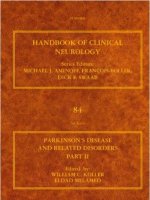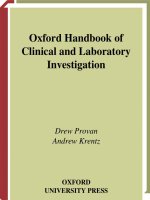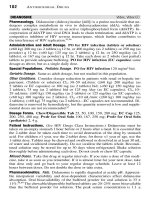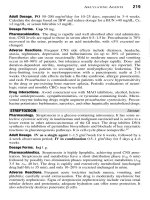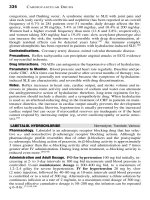Oxford Handbook of Clinical Haematology (4e 2015)
Bạn đang xem bản rút gọn của tài liệu. Xem và tải ngay bản đầy đủ của tài liệu tại đây (9.57 MB, 870 trang )
Haematological emergencies
Septic shock/neutropenic fever E p636
Acute transfusion reactions E p638
Delayed transfusion reaction E p642
Post-transfusion purpura E p643
Hypercalcaemia E p644
Hyperviscosity E p646
Disseminated intravascular coagulation E p648
Overdosage of thrombolytic therapy E p651
Heparin overdosage E p652
Heparin-induced thrombocytopenia (HIT) E p654
Warfarin overdosage E p656
Massive blood transfusion E p658
Paraparesis/spinal collapse E p662
Leucostasis E p663
Thrombotic thrombocytopenic purpura E p664
Sickle crisis E p666
Tumour lysis syndrome (TLS) E p690
oxford medical publications
Oxford Handbook of
Clinical
Haematology
Published and forthcoming Oxford Handbooks
Oxford Handbook for the Foundation Programme 4/e
Oxford Handbook of Acute Medicine 3/e
Oxford Handbook of Anaesthesia 2/e
Oxford Handbook of Applied Dental Sciences
Oxford Handbook of Cardiology 2/e
Oxford Handbook of Clinical and Laboratory Investigation 2/e
Oxford Handbook of Clinical Dentistry 6/e
Oxford Handbook of Clinical Diagnosis 3/e
Oxford Handbook of Clinical Examination and Practical Skills 2/e
Oxford Handbook of Clinical Haematology 4/e
Oxford Handbook of Clinical Immunology and Allergy 3/e
Oxford Handbook of Clinical Medicine—Mini Edition 9/e
Oxford Handbook of Clinical Medicine 9/e
Oxford Handbook of Clinical Pharmacy
Oxford Handbook of Clinical Rehabilitation 2/e
Oxford Handbook of Clinical Specialties 9/e
Oxford Handbook of Clinical Surgery 4/e
Oxford Handbook of Complementary Medicine
Oxford Handbook of Critical Care 3/e
Oxford Handbook of Dental Patient Care 2/e
Oxford Handbook of Dialysis 3/e
Oxford Handbook of Emergency Medicine 4/e
Oxford Handbook of Endocrinology and Diabetes 3/e
Oxford Handbook of ENT and Head and Neck Surgery
Oxford Handbook of Epidemiology for Clinicians
Oxford Handbook of Expedition and Wilderness Medicine
Oxford Handbook of Gastroenterology and Hepatology
Oxford Handbook of General Practice 4/e
Oxford Handbook of Genitourinary Medicine, HIV and AIDS
Oxford Handbook of Geriatric Medicine 2/e
Oxford Handbook of Infectious Diseases and Microbiology
Oxford Handbook of Key Clinical Evidence
Oxford Handbook of Medical Sciences 2/e
Oxford Handbook of Nephrology and Hypertension 2/e
Oxford Handbook of Neurology 2/e
Oxford Handbook of Nutrition and Dietetics
Oxford Handbook of Obstetrics and Gynaecology 3/e
Oxford Handbook of Occupational Health 2/e
Oxford Handbook of Oncology 3/e
Oxford Handbook of Ophthalmology 3/e
Oxford Handbook of Paediatrics 2/e
Oxford Handbook of Palliative Care 2/e
Oxford Handbook of Practical Drug Therapy
Oxford Handbook of Pre-Hospital Care
Oxford Handbook of Psychiatry 2/e
Oxford Handbook of Public Health Practice 3/e
Oxford Handbook of Reproductive Medicine and Family Planning 2/e
Oxford Handbook of Respiratory Medicine 3/e
Oxford Handbook of Rheumatology 3/e
Oxford Handbook of Sport and Exercise Medicine
Oxford Handbook of Tropical Medicine 4/e
Oxford Handbook of Urology 3/e
Oxford Handbook of
Clinical
Haematology
FOURTH EDITION
Drew Provan
Reader in Haematology
Barts & The London School of Medicine and Dentistry
Queen Mary University of London, UK
Trevor Baglin
Consultant Haematologist
Addenbrooke’s NHS Trust
Cambridge, UK
Inderjeet Dokal
Chair of Child Health and Centre Lead
Barts & The London School of Medicine and Dentistry
Queen Mary University of London
Honorary Consultant
Barts Health NHS Trust
London, UK
Johannes de Vos
Consultant Haematologist
Royal Surrey County Hospital NHS Foundation Trust
Guildford, UK
1
1
Great Clarendon Street, Oxford, OX2 6DP,
United Kingdom
Oxford University Press is a department of the University of Oxford.
It furthers the University’s objective of excellence in research, scholarship,
and education by publishing worldwide. Oxford is a registered trade mark of
Oxford University Press in the UK and in certain other countries
© Oxford University Press 2015
The moral rights of the authors have been asserted
First Edition published in 1998
Second Edition published in 2004
Third Edition published in 2009
Fourth Edition published in 2015
Impression: 1
All rights reserved. No part of this publication may be reproduced, stored in
a retrieval system, or transmitted, in any form or by any means, without the
prior permission in writing of Oxford University Press, or as expressly permitted
by law, by licence or under terms agreed with the appropriate reprographics
rights organization. Enquiries concerning reproduction outside the scope of the
above should be sent to the Rights Department, Oxford University Press, at the
address above
You must not circulate this work in any other form
and you must impose this same condition on any acquirer
Published in the United States of America by Oxford University Press
198 Madison Avenue, New York, NY 10016, United States of America
British Library Cataloguing in Publication Data
Data available
Library of Congress Control Number: 2014943849
Typeset by Greengate Publishing Services, Tonbridge, UK
ISBN 978-0-19-968330-7
Printed in China by
C&C Offset Printing Co. Ltd
Oxford University Press makes no representation, express or implied, that the drug
dosages in this book are correct. Readers must therefore always check the product
information and clinical procedures with the most up-to-date published product
information and data sheets provided by the manufacturers and the most recent
codes of conduct and safety regulations. The authors and the publishers do not
accept responsibility or legal liability for any errors in the text or for the misuse or
misapplication of material in this work. Except where otherwise stated, drug dosages
and recommendations are for the non-pregnant adult who is not breast-feeding.
Links to third party websites are provided by Oxford in good faith and
for information only. Oxford disclaims any responsibility for the materials
contained in any third party website referenced in this work.
v
Preface to the fourth
edition
The world of haematology has been exciting over the past few years,
and we have seen major advances since the third edition of the Oxford
Handbook of Clinical Haematology was published. These are most
obvious in haemato-oncology, with the development of new agents and
regimens for treating malignant haematology disorders. But there have
also been advances in haemostasis and red cell haematology with the
arrival of the novel oral anticoagulation drugs and new oral chelators
for the treatment of iron overload, in addition to a number of other
advances.
This edition sees a change of editorial team and we are very happy to
have John de Vos, haemato-oncologist, on board. He has overhauled the
haemato-oncology sections bringing them thoroughly up to date. We
have also sought the advice of Shubha Allard, consultant in transfusion
medicine, to make sure the blood transfusion section is accurate, in addition to Banu Kaya, a red cell haematologist who has brought the red cell
material up to date.
For the first time, we have incorporated a new chapter on rare disorders which we hope readers will find useful.
We are very grateful to the editorial team at Oxford University Press
for their patience and hard work, especially Liz Reeve and Michael
Hawkes.
There may be errors or omissions from the book and we would
welcome any comments or feedback (email ).
We will try to incorporate these in future editions.
DP
TB
ID
JdV
January 2014
vi
Preface to the third
edition
It is hard to believe that at least three years have passed since the second
edition of the handbook. As with all medical specialties, Haematology
has seen major inroads with new diagnostic tests, treatments and a
plethora of guidelines. In fact, Haematology has the largest collection
of guidelines covering all aspects of haematology care (M http://www.
bcshguidelines. com) and was the first specialty to design guidelines in
the 1980s.
The book underwent a major revision with the second edition, most
notably the sections dealing with malignant disease. For the new edition
these have been brought right up to date by Charles Singer. Coagulation
has been entirely rewritten by Trevor Baglin and now truly reflects
the current investigation and management of coagulation disorders.
Following the retirement of Professor Sir John Lilleyman we needed to
find a new author for the Paediatric Haematology component of the
book. Thankfully, we were able to persuade Professor Inderjeet Dokal
to take on this mantle and he has revised this section thoroughly.
In addition to these significant changes, we have gone through the
entire book and attempted to ensure that obsolete tests have been
removed and that the Handbook, in its entirety, reflects contemporary
haematology practice.
As ever, we are very keen to hear about errors or omissions, for which
we are entirely responsible! We would also very much like readers to
contact us if there are topics or subject areas which they would like to
see included in the fourth edition. We also need more trainee input so
if there are any volunteer proof-readers or accuracy checkers among
the haematology trainee community we would very much like to hear
from you.
DP
CRJS
TB
ISD
2008
vii
Foreword to the fourth
edition
The Concise Oxford English Dictionary defines a handbook as ‘a short
manual or guide’. Modern haematology is a vast field which involves
almost every other medical speciality and which, more than most,
straddles the worlds of the basic biomedical sciences and clinical practice. Since the rapidly proliferating numbers of textbooks on this topic
are becoming denser and heavier with each new edition, the medical
student and young doctor in training are presented with a daunting
problem, particularly as they try to put these fields into perspective. And
those who try to teach them are not much better placed; on the one
hand they are being told to decongest the curriculum, while on the other
they are expected to introduce large slices of molecular biology, social
science, ethics, and communication skills, not to mention a liberal sprinkling of poetry, music, and art.
In this over-heated educational scene the much maligned ‘handbook’
could well stage a comeback and gain new respectability, particularly in
the role of a friendly guide. In the past this genre has often been viewed
as having little intellectual standing, of no use to anybody except the
panic-stricken student who wishes to try to make up for months of misspent time in a vain, one-night sitting before their final examination. But
given the plethora of rapidly changing information that has to be assimilated, the carefully prepared précis is likely to play an increasingly important role in medical education. Perhaps even that ruination of the decent
paragraph and linchpin of the pronouncements of medical bureaucrats,
the ‘bullet point’, may become acceptable, albeit in small doses, as
attempts are made to highlight what is really important in a scientific or
clinical field of enormous complexity and not a little uncertainty.
In the fourth edition of this short account of blood diseases the editors
have continued to provide an excellent service to medical students, as well
as doctors who are not specialists in blood diseases, by summarizing in
simple terms the major features and approaches to diagnosis and management of most of the blood diseases that they will encounter in routine
clinical practice or in the tedious examinations that face them. And, of
equal importance, they have been able to update and summarize some of
the major advances that have been made in this rapidly moving field since
the appearance of the early editions of this handbook. As in previous editions they have managed to avoid one of the major pitfalls of this type of
teaching: in trying to reduce complex issues down to their bare bones it is
all too easy to introduce inaccuracies.
One word of warning from a battle-scarred clinician however. A précis
of this type suffers from the same problem as a set of multiple-choice
questions. Human beings are enormously complex organisms, and sick
ones are even more complicated; during a clinical lifetime the self-critical
doctor will probably never encounter a ‘typical case’ of anything. Thus the
viii
FOREWORD TO THE FOURTH EDITION
outlines of the diseases that are presented in this book must be used as
approximate guides, and no more. But provided they bear this in mind,
students will find that it is a very valuable summary of modern haematology; the addition of the Internet sources is a genuine and timely bonus.
D. J. Weatherall
Oxford, June 2014
ix
Contents
Acknowledgements x
Contributors xi
Symbols and abbreviations xiii
1
2
3
4
5
6
7
8
9
10
11
12
13
14
15
16
17
18
Clinical approach
Red cell disorders
White blood cell abnormalities
Leukaemia
Lymphoma
Myelodysplasia
Myeloproliferative neoplasms
Paraproteinaemias
Haematopoietic stem cell transplantation
Haemostasis and thrombosis
Immunodeficiency
Paediatric haematology
Haematological emergencies
Supportive care
Protocols and procedures
Haematological investigations
Blood transfusion
Rare diseases
1
31
113
123
181
227
257
325
387
453
545
559
635
667
675
745
759
783
Appendix 1 Haematology online
Appendix 2 Charts and nomograms
Appendix 3 Normal ranges
795
803
809
Index 813
x
Acknowledgements
We are indebted to many of our colleagues for providing helpful
suggestions and for proofreading the text. In particular we wish to
thank Dr Helen McCarthy, Specialist Registrar in Haematology; Dr Jo
Piercy, Specialist Registrar in Haematology; Dr Tanay Sheth, SHO in
Haematology, Southampton; Sisters Clare Heather and Ann Jackson,
Haematology Day Unit, Southampton General Hospital; Dr Mike
Williams, Specialist Registrar in Anaesthetics; Dr Frank Boulton, Wessex
Blood Transfusion Service, Southampton; Dr Paul Spargo, Consultant
Anaesthetist, Southampton University Hospitals; Dr Sheila Bevin, Staff
Grade Paediatrician; Dr Mike Hall, Consultant Neonatologist; Dr Judith
Marsh, Consultant Haematologist, St George’s Hospital, London;
Joan Newman, Haematology Transplant Coordinator, Southampton;
Professor Sally Davies, Consultant Haematologist, Imperial College
School of Medicine, Central Middlesex Hospital, London; Dr Denise
O’Shaughnessy, Consultant Haematologist, Southampton University
Hospitals NHS Trust; Dr Kornelia Cinkotai, Consultant Haematologist,
Barts and The London NHS Trust; Dr Mansel Haeney, Consultant
Immunologist, Hope Hospital, Salford; Dr Adam Mead, Specialist
Registrar Barts and The London; Dr Chris Knechtli, Consultant
Haematologist, Royal United Hospital, Bath; Dr Toby Hall, Consultant
Radiologist, Royal United Hospital Bath, Craig Lewis, Senior Biomedical
Scientist, Royal United Hospital Bath, Bob Maynard, Senior Biomedical
Scientist, Royal United Hospital Bath and Rosie Simpson, Senior
Pharmacist, Royal United Hospital Bath. We would like to thank Alastair
Smith, Morag Chisholm, and Andrew Duncombe for their contributions
to the first edition of the handbook. Three Barts & The London SpRs
helped edit some of the sections of the third edition, namely Drs John
de Vos, Tom Butler, and Jay Pandya. Dr Jim Murray, Queen Elizabeth
Hospital, Birmingham, corrected the ‘Haematological emergencies’
section, though he did this in error since he was supposed to be proofreading something completely different but he was too polite to say
anything (bless).
We would like to acknowledge the patience and forbearance of our
wives and families for the months of neglect imposed by the work on
this edition. Warm thanks, as ever, are extended to Oxford University
Press, and in particular Catherine Barnes, Senior Commissioning Editor
for Medicine, Elizabeth Reeve, Commissioning Editor, Beth Womack,
Managing Editor, and Kate Wilson, Production Manager. We fell behind
schedule with this edition and are grateful to the whole OUP team for
bearing with us so patiently and not harassing us! We apologize for
anyone omitted but this is entirely unintentional.
xi
Contributors
Shubha Allard
Consultant Haematologist
Barts Health NHS Trust, and NHS Blood & Transplant, UK
Banu Kaya
Consultant Haematologist
Barts Health NHS Trust, UK
This page intentionally left blank
xiii
Symbols and
abbreviations
E
d
i
2
3
n
M
♀
♂
1°
2°
2,3 DPG
2-CDA
A2-M
6-MP
99mTc-MIBI
AA
Ab
ABVD
ACD
ACE
ACL
ACML
ADA
ADE
ADP
AFB
Ag
AIDS
AIHA
AIN
AITL
AL
ALB
cross-reference
decreased
increased
important
very important
normal
website
female
male
primary
secondary
2,3 diphosphoglycerate
2-chlorodeoxyadenosine
alpha-2 microglobulin
6-mercaptopurine
99mTc methoxyisobutyl-isonitride or 99mTc-MIBI scintigraphy
aplastic anaemia or reactive amyloidosis
antibody
adriamycin (doxorubicin), bleomycin, vinblastine,
dacarbazine
acid-citrate-dextrose or anaemia of chronic disease
angiotensin converting-enzyme
anticardiolipin antibody
atypical chronic myeloid leukaemia
adenosine deaminase
cytosine arabinoside (Ara-C) daunorubicin etoposide
adenosine 5-diphosphate
acid-fast bacilli
antigen
acquired immunodeficiency syndrome
autoimmune haemolytic anaemia
autoimmune neutropenia
angio-immunoblastic T-cell lymphoma
(1°) amyloidosis
serum albumin
xiv
SYMBOLS AND ABBREVIATIONS
ALCL
ALG
ALIPs
ALL
ALS
ALT
AML
AMP
ANA
ANAE
ANCA
ANH
APC
APCR
APL
APML
APS
APTR
APTT
ARDS
ARF
ARMS
ASCT
AST
AT (ATIII)
ATCML
ATG
ATLL
ATP
ATRA
A-V
AvWS
β2-M
BAL
B-CLL
bd
BEAC
BEAM
anaplastic large cell lymphoma
antilymphocyte globulin
abnormal localization of immature myeloid precursors
acute lymphoblastic leukaemia
advanced life support
alanine aminotransferase
acute myeloid leukaemia
adenosine monophosphate
antinuclear antibodies
alpha naphthyl acetate esterase
antineutrophilic cytoplasmic antibody
acute normovolaemic haemodilution
activated protein C
activated protein C resistance
antiphospholipid antibody
acute promyelocytic leukaemia
antiphospholipid syndrome
activated partial thromboplastin ratio
activated partial thromboplastin time
adult respiratory distress syndrome
acute renal failure
amplification refractory mutation system
autologous stem cell transplantation
aspartate aminotranferase
antithrombin III
adult-type chronic myeloid (granulocytic) leukaemia
antithymocyte globulin
adult T-cell leukaemia/lymphoma
adenosine triphosphate
all-trans retinoic acid
arteriovenous
acquired von Willebrand syndrome
beta-2-microglobulin
broncho-alveolar lavage
B-cell chronic lymphocytic leukaemia
bis die (twice daily)
BCNU (Carmustine), etoposide, cytosine,
cyclophosphamide
BCNU (Carmustine), etoposide, cytarabine (ara-C),
melphalan
SYMBOLS AND ABBREVIATIONS
BFU-E
BJP
BL
BM
BMJ
BMM
BMT
BNF
BP
BPL
BSS
BTG
BU
C/I
Ca
Ca2+
CABG
cALL
CAMT
CaPO4
CBA
CBV
CCF
CCR
CD
CDA
cDNA
CEL
CGL
CHAD
CHOP
CJD
Cl−
CLD
CLL
CM
CMC
CML
CMML
CMV
burst-forming unit-erythroid
Bence Jones protein
Burkitt lymphoma
bone marrow
British Medical Journal
bone marrow mastocytosis
bone marrow transplantation
British National Formulary
blood pressure
BioProducts Laboratory
Bernard–Soulier syndrome
β-thromboglobulin
Bethesda units
consolidation/intensification
carcinoma
calcium
coronary artery bypass graft
common acute lymphoblastic leukaemia
congenital amegakaryocytic thrombocytopenia
calcium phosphate
collagen binding activity
cyclophosphamide, carmustine (BCNU), etoposide
congestive cardiac failure
complete cytogenetic response
cluster differentiation or designation
congenital dyserythropoietic anaemia
complementary DNA
chronic eosinophilic leukaemia
chronic granulocytic leukaemia
cold haemagglutinin disease
cyclophosphamide, doxorubicin, vincristine, prednisolone
Creutzfeldt–Jakob disease (v = variant)
chloride
chronic liver disease
chronic lymphocytic (‘lymphatic’) leukaemia
cutaneous mastocytosis
chronic mucocutaneous candidiasis
chronic myeloid leukaemia
chronic myelomonocytic leukaemia
cytomegalovirus
xv
xvi
SYMBOLS AND ABBREVIATIONS
CNS
COAD
COC
CR
CRF
CRP
CRVT
CsA
CSF
CT
CTLp
CTZ
CVA
CVP
CVS
CVS
CXR
CyA
CytaBOM
d
DAGT
DAT
dATP
DBA
DC
DCS
DCT
DDAVP
DEAFF
DEB
DFS
DHAP
DI
DIC
dL
DLBCL
DLI
DMSO
DNA
central nervous system
chronic obstructive airways disease
combined oral contraceptive
complete remission
chronic renal failure
C-reactive protein
central retinal venous thrombosis
ciclosporin A
cerebrospinal fluid
computed tomography
cytotoxic T-lymphocyte precursor assays
chemoreceptor trigger zone
cerebrovascular accident
cyclophosphamide, vincristine, prednisolone; central
venous pressure
chorionic villus sampling
cardiovascular system
chest x-ray
ciclosporin A
cytarabine, bleomycin, vincristine, methotrexate
day
direct antiglobulin test
direct antiglobulin test daunorubicin, cytosine (Ara-C),
deoxy ATP
Diamond–Blackfan anaemia
dyskeratosis congenita
dendritic cell system
direct Coombs’ test
desamino D-arginyl vasopressin
detection of early antigen fluorescent foci
diepoxy butane
disease-free survival
dexamethasone, cytarabine, cisplatin
delayed intensification
disseminated intravascular coagulation
decilitre
diffuse large B-cell lymphoma
donor leucocyte/lymphocyte infusion
dimethyl sulphoxide
deoxyribonucleic acid
SYMBOLS AND ABBREVIATIONS
DOB
DPG
DRVVT
DTT
DVT
DXT
EACA
EBV
EBVP
ECG
ECOG
EDTA
EEC
EFS
EGF
ELISA
EMEA
EMH
EMU
EPO
EPOCH
EPS
ESHAP
ESR
ET
ETTL
FAB
FACS
FBC
FCM
FDG-PET
FDP
Fe
FEIBA
FEL
FeSO4
FFP
FFS
Fgn
date of birth
diphosphoglycerate
dilute Russell’s viper venom time/test
dilute thromboplastin time
deep vein thrombosis
radiotherapy
epsilon aminocaproic acid
Epstein–Barr virus
etoposide, bleomycin, vinblastine, prednisolone
electrocardiograph
European Co-operative Oncology Group
ethylenediamine tetraacetic acid
endogenous erythroid colonies
event-free survival
epidermal growth factor
enzyme-linked immunosorbent assay
European Medicines Agency
extramedullary haemopoietic
early morning urine
erythropoietin
etoposide, vincristine, doxorubicin, cyclophosphamide,
prednisone
electrophoresis
etoposide, methylprednisolone, cytarabine, platinum
erythrocyte sedimentation rate
essential thrombocythaemia or exchange transfusion
enteropathy type T-cell lymphoma
French–American–British
fluorescence-activated cell sorter
full blood count
fludarabine, cyclophosphamide, melphalan
18fluoro–D–2–deoxyglucose positron emission tomography
fibrin degradation products
iron
factor eight inhibitor bypassing activity
familial erythrophagocytic lymphohistiocytosis
ferrous sulfate
fresh frozen plasma
failure-free survival
fibrinogen
xvii
xviii
SYMBOLS AND ABBREVIATIONS
FH
FISH
FITC
FIX
fL
FL
FNA
FNHTR
FOB
FVIII
FVL
g
G&S
G6PD
GA
GCS
G-CSF
GI
GIT
GM-CSF
GP
GPI
GPS
GT
GvHD
GvL
h
HAART
HAV
Hb
HbA
HbA2
HbF
HbH
HBsAg
HBV
HC
HCD
HCG
HCII
family history
fluorescence in situ hybridization
fluorescein isothiocyanate
factor IX
femtolitre
follicular lymphoma
fine needle aspirate
febrile non-haemolytic transfusion reaction
faecal occult blood
factor VIII
factor V Leiden
gram
group, screen, and save
glucose-6-phosphate dehydrogenase
general anaesthetic
graded compression stockings
granulocyte colony stimulating factor
gastrointestinal
gastrointestinal tract
granulocyte macrophage colony stimulating factor
glycoprotein
glycosylphosphatidylinositol
grey platelet syndrome
Glanzmann thrombasthenia
graft-versus-host disease
graft versus leukaemia
hour
highly active antiretroviral therapy
hepatitis A virus
haemoglobin
haemoglobin A
haemoglobin A2
haemoglobin F (fetal Hb)
haemoglobin H
hepatitis B surface antigen
hepatitis B virus
hydroxycarbamide or heavy chain
heavy chain disease
human chorionic gonadotrophin
heparin cofactor II
SYMBOLS AND ABBREVIATIONS
HCL
HCO3
Hct
HCV
HD
HDM
HDN
HDT
HE
HELLP
HES
HHT
HI
HIT(T)
HIV
HL
HLA
HLH
HMP
HMW
HMWH
HMWK
HPA
HPF
HPFH
HPLC
HPP
HRT
HS
HTC
HTLV-1
HTO
HUMARA
HUS
IAGT
IAHS
ICE
ICH
ICUS
hairy cell leukaemia
bicarbonate
haematocrit
hepatitis C virus
haemodialysis
high-dose melphalan
haemolytic disease of the newborn
high-dose therapy
hereditary elliptocytosis
haemolysis, elevated liver enzymes and low platelets
hypereosinophilic syndrome
hereditary haemorrhagic telangiectasia
haematological improvement
heparin-induced thrombocytopenia (with thrombosis)
human immunodeficiency virus
Hodgkin lymphoma (Hodgkin disease)
human leucocyte antigen
haemophagocytic lymphohistiocytosis
hexose monophosphate shunt
high molecular weight
high molecular weight heparin
high-molecular-weight kininogen
human platelet antigen
high power field
hereditary persistence of fetal haemoglobin
high-performance liquid chromatography
hereditary pyropoikilocytosis
hormone replacement therapy
hereditary spherocytosis
hospital transfusion committee
human T-lymphotropic virus type 1
high titre antibodies
human androgen receptor gene assay
haemolytic uraemic syndrome
indirect antiglobulin test
infection-associated haemophagocytic syndrome
ifosfamide, carboplatin, etoposide
intracranial haemorrhage
idiopathic cytopenia of uncertain (undetermined)
significance
xix
xx
SYMBOLS AND ABBREVIATIONS
IDA
IF
IFA
IFRT
Ig
IgA
IgD
IgE
IgG
IgM
IL-1
IM
IMF
INR
inv
IPC
IPF
IPI
IPSS
ISM
ISS
IST
IT
ITP
ITU
IU
IUGR
IUT
IV
IVI
IVIg
JCMML
JML
JVP
KCT
kg
L
LA
LAP
LC
iron deficiency anaemia
involved field (radiotherapy)
intrinsic factor antibody
involved field radiotherapy
immunoglobulin
immunoglobulin A
immunoglobulin D
immunoglobulin E
immunoglobulin G
immunoglobulin M
interleukin-1
intramuscular
idiopathic myelofibrosis
international normalized ratio
chromosomal inversion
intermittent pneumatic compression devices
immature platelet fraction
International Prognostic Index
International Prognostic Scoring System
Indolent systemic mastocytosis
International Sensitivity Index
immune suppressive therapy
intrathecal
idiopathic thrombocytopenic purpura
Intensive Therapy Unit
international units
intrauterine growth retardation
intrauterine transfusion
intravenous
intravenous infusion
intravenous immunoglobulin
juvenile chronic myelomonocytic leukaemia
juvenile myelomonocytic leukaemia
jugular venous pressure
kaolin clotting time
kilogram
litre
lupus anticoagulant
leucocyte alkaline phosphatase (score)
light chain
SYMBOLS AND ABBREVIATIONS
LCH
LDH
LDHL
LFS
LFTs
L&H
LGL
LLN
LMWH
LN
LP
LPD
LRCHL
LSCS
LTC
M&P
MACOP-B
MAHA
MALT
m-BACOD
mcg
MC
MCH
MCHC
MCHL
MCL
MCP
MCR
MCS
MC&S
M-CSF
MCV
MDS
MetHb
MF
mg
MGUS
MHC
Langerhans cell histiocytosis
lactate dehydrogenase
lymphocyte depleted Hodgkin lymphoma
leukaemia-free survival
liver function tests
lymphocytic and histiocytic
large granular lymphocyte
lower limit of normal
low-molecular-weight heparin
lymph node(s)
lumbar puncture
lymphoproliferative disorder
lymphocyte-rich classical HL
lower segment Caesarian section
large transformed cells
melphalan and prednisolone
methotrexate, doxorubicin, cyclophosphamide,
vincristine, bleomycin, prednisolone
microangiopathic haemolytic anaemia
mucosa-associated lymphoid tissue
methotrexate, bleomycin, doxorubicin (adriamycin),
cyclophosphamide, vincristine, dexamethasone
microgram
mast cell(s)
mean cell haemoglobin
mean corpuscular haemoglobin concentration
mixed cellularity Hodgkin lymphoma
mast cell leukaemia or mantle cell lymphoma
mitoxantrone, chlorambucil, prednisolone
major cytogenetic response
mast cell sarcoma
microscopy, culture, and sensitivity
macrophage colony stimulating factor
mean cell volume
myelodysplastic syndrome
methaemoglobin
myelofibrosis
milligram
monoclonal gammopathy of undetermined significance
major histocompatibility complex
xxi
xxii
SYMBOLS AND ABBREVIATIONS
MI
min
mL
MLC
MM
MMC
MNC
MoAb
MP
MPCM
MPD
MPN
MPO
MPS
MPT
MPV
MRD
MRI
mRNA
MRSA
MSBOS
MSU
MT
MTX
MUD
MW
MZL
Na+
NaCl
NADP
NADPH
NAIT
NAP
NBT
NCCN
NEJM
NHL
NLPHL
NRBC
NS
myocardial infarction
minute
millilitre
mixed lymphocyte culture
multiple myeloma
mitomycin C
mononuclear cell(s)
monoclonal antibody
melphalan and prednisolone
maculopapular cutaneous mastocytosis
myeloproliferative disease
myeloproliferative neoplasm
myeloperoxidase
mononuclear phagocytic system
melphalan, prednisolone, and thalidomide
mean platelet volume
minimal residual disease
magnetic resonance imaging
messenger ribonucleic acid
meticillin-resistant Staphylococcus aureus
maximum surgical blood ordering schedule
midstream urine
mass: thoracic
methotrexate
matched unrelated donor (transplant)
molecular weight
mantle zone lymphoma
sodium
sodium chloride
nicotinamide adenine diphosphate
nicotinamide adenine diphosphate (reduced)
neonatal alloimmune thrombocytopenia
neutrophil alkaline phosphatase
nitro blue tetrazolium
National Comprehensive Cancer Network
New England Journal of Medicine
non-Hodgkin lymphoma
nodular lymphocyte predominant HL
nucleated red blood cells
nodular sclerosing
SYMBOLS AND ABBREVIATIONS
NS
NSAID
NSE
NSHL
OAF
OB
OC
OCP
od
OPG
OPG
OR
OS
OWR
PA
PAI
PaO2
PAS
PB
PBSC
PBSCH
PBSCT
PC
PCC
PCH
PCL
PCP
PCR
PCV
PD
PDGF
PDW
PE
PEP
PET
PF
PFA
PFK
PFS
non-secretory (myeloma)
non-steroidal anti-inflammatory drug
non-specific esterase
nodular sclerosing HL
OC-activating factor
osteoblast
osteoclast
oral contraceptive pill
omni die (once daily)
osteoprotogerin
orthopantomogram
overall response
overall survival
Osler–Weber–Rendu
pernicious anaemia
plasminogen activator inhibitor
partial pressure of O2 in arterial blood
periodic acid–Schiff
peripheral blood
peripheral blood stem cell
peripheral blood stem cell harvest
peripheral blood stem cell transplant
protein C
prothrombin complex concentrate
paroxysmal cold haemoglobinuria
plasma cell leukaemia
Pneumocystis carinii (jirovecii) pneumonia
polymerase chain reaction
packed cell volume
peritoneal dialysis
platelet-derived growth factor
platelet distribution width
pulmonary embolism
post-expoure prophylaxis
pre-eclamptic toxaemia or position emission
tomography
platelet factor
platelet function analysis
phosphofructokinase
progression-free survival
xxiii


